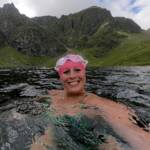
Wild swimming guru Alice Goodridge chooses her favourite walks to combine with a sea, river or loch dip.
Scotland is a wild swimmer’s paradise, as long as you like cold water! There are over 25,000 freshwater lochs and lochans, along with more than 125,000 kilometres of rivers and streams, varying from deep, wide lowland rivers to small highland burns. There are also around 18,000 kilometres of coastline (including numerous sea lochs). With so much water, we are certainly spoilt for choice when it comes to swimming.
Having swum in the pool from a young age, I switched to open water over a decade ago and have never looked back. Now I swim outside almost every day, all year round, whatever the weather.
Since moving to the Highlands in 2013, my love of swimming has been my route to exploring Scotland’s watery landscape. Starting close to home in the Cairngorms National Park, I’ve swum my way around local lochs, circumnavigated castles, swooshed along rivers and ventured up into the hills to dip in remote mountain lochs and waterfalls.
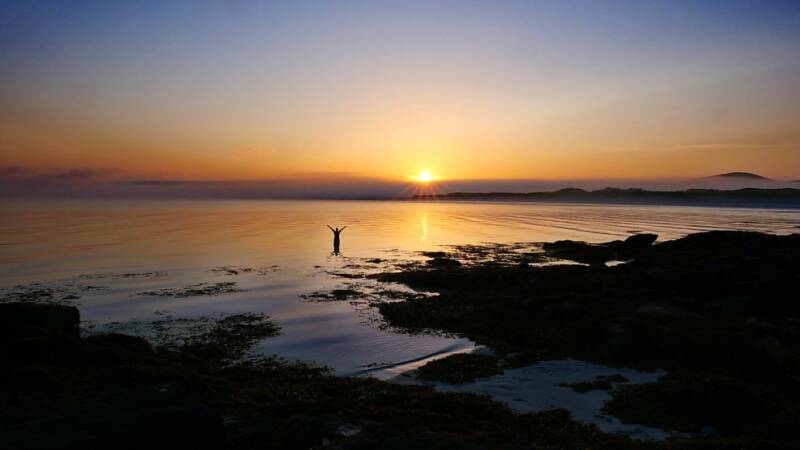
Further afield, I’ve been lucky enough to lead multiple swimming expeditions around Skye, the Small Isles, the Outer Hebrides and St Kilda. I’ve explored the remote Ardnamurchan and Knoydart peninsulas, visited friends to dip around the coast of Orkney and travelled to Unst – one of the Shetland Islands – to swim at the most northerly beach in the UK.
I love to combine walking and swimming whenever I can. Here are a few of my favourite swim walk locations –
Lower Pattack Falls, Kinloch Laggan
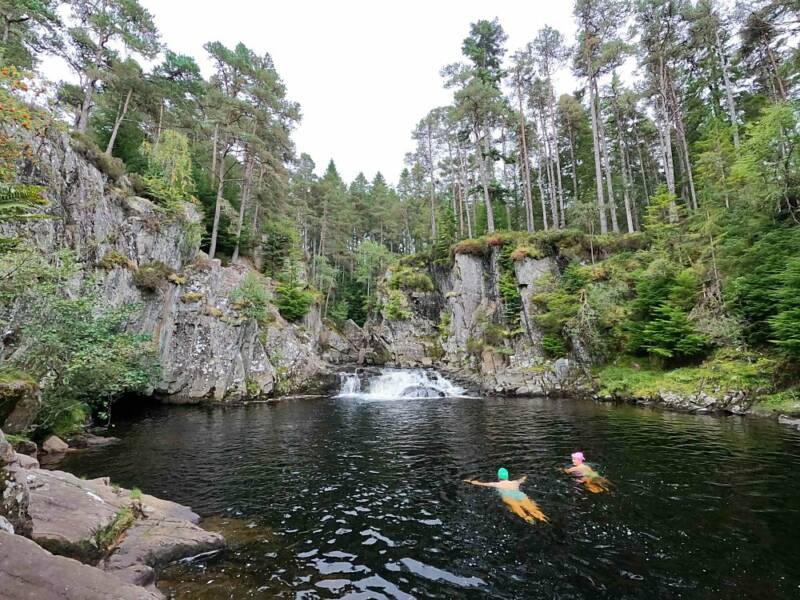
With the dark pool, rocky gorge and trees towering above, these waterfalls on the River Pattack have an otherworldly, prehistoric feel. It’s easy to get carried away and think you are in the middle of nowhere, but this swimming spot is actually very accessible, close to the A86 near Kinloch Laggan.
Entry to the large pool is via a short section of the river, which is very stony underfoot (protective footwear recommended). Swim or wade upstream into the pool and then, after your swim, float back to where you started.
Once you are in the main pool, it is more of a float-around-and-play than a proper swim. Beneath the viewpoint, there is a cave in the rocks. This is a tunnel diverting water from the River Mashie via an aqueduct to join the River Pattack. Local kids have been known to dare each other to swim up the tunnel – this is definitely not recommended!
Getting there
The lower Pattack Falls are easily accessible by car, just off the A86 between Laggan and Strath Mashie. Keep a close eye out for the car park as it can be easy to miss. To access the swim entry point from the car park, take the lower path to the right, which takes you down to the river. Providing the water level is low (which it needs to be if you are going to swim), there is a nice little sandy area for changing.
While the swim spot is only a short walk from the car park, you can easily combine it with a longer walk to the deserted village of Druim an Aird or head just a bit further along the A86 and hike to the even more impressive Falls of Pattack.
Tràigh an t-Suidhe, Iona
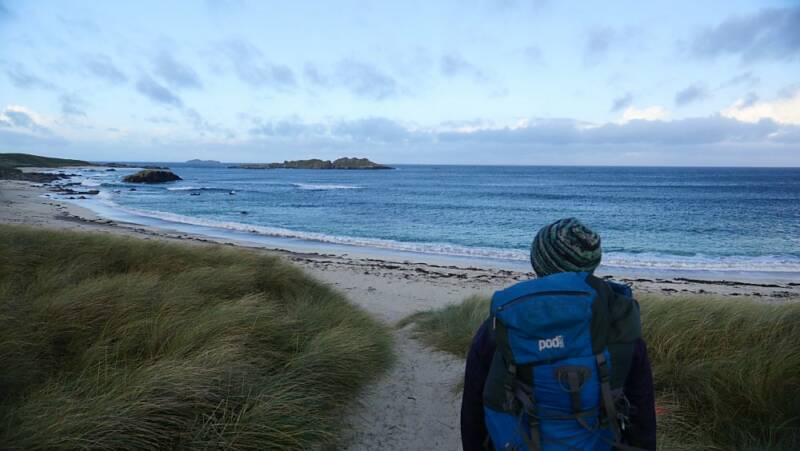
I love swimming at Tràigh an t-Suidhe (strand of the seat) with its amazing views to Coll, Tiree and the Treshnish Isles – the Dutchman’s Cap (easy to spot), Lunga (known for its seabirds) and Fladda (the flat one). On a clear day, you can also see the peaks of Rùm and Skye further in the distance. After my last swim here, I saw a minke whale in the middle of the bay as I warmed up on the shore.
Swimming here is best at high tide. I prefer to head down to the bay’s western end and get in close to Eilean Chalbha (Calf Island). This part of the beach tends to be more sheltered than the eastern end, which often has larger waves and stronger currents.
Getting there
From the ferry take the road heading north, past Iona Abbey, to the end of the tarmac. Go straight ahead through a gate (passing a track on your left leading to a farm and hostel). Take the first or second left turn after this to get down to the beach on the island’s northern side. If you’d like to do some extra exploring, you can get to the beach while doing the walk to Iona Abbey, Dùn Ì and the north end of the island.
Loch Muick, near Ballater
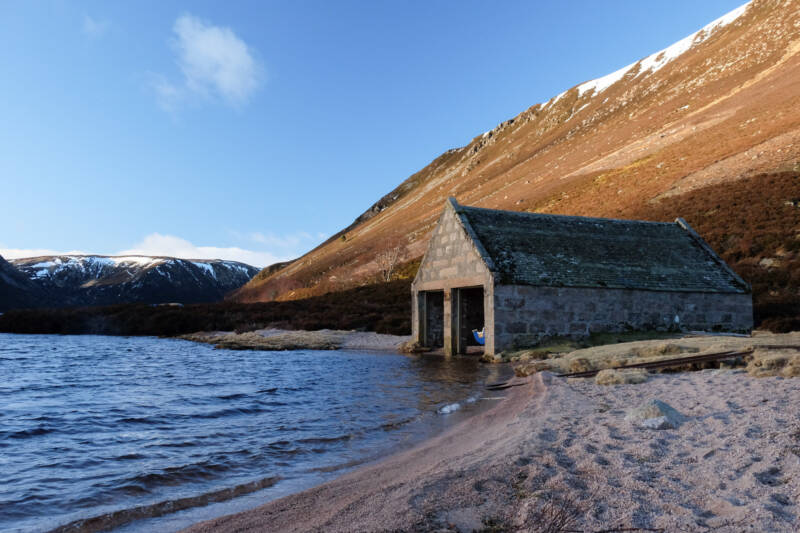
Loch Muick has royal connections and is part of the Balmoral Estate. Queen Victoria used to enjoy fishing trips on the loch and built a lodge along the western shore, where she spent a lot of time after the death of Prince Albert.
It is stunning and usually rather wild and bleak whenever I have swum here. You can get in the water anywhere along the northern shore; however, it is quite a stony entry, and there is no shelter. My preferred entry spot is a little further along the track (around 500 metres beyond the bridge), where there is a boathouse and a pebbly and sandy beach. Although pretty shallow to start with it eventually gets deep enough to swim.
Getting there
From the car park, walk over the bridge and past the visitor centre building; keep heading in the same direction (south) until you can see the loch and the path splits. Take the right-hand, lower path and then turn right again. This path takes you over a bridge and to the northern shore of the loch. Fancy a longer walk? Enjoy a dip on your way around the Loch Muick Circuit.
Claigan coral beach, Skye
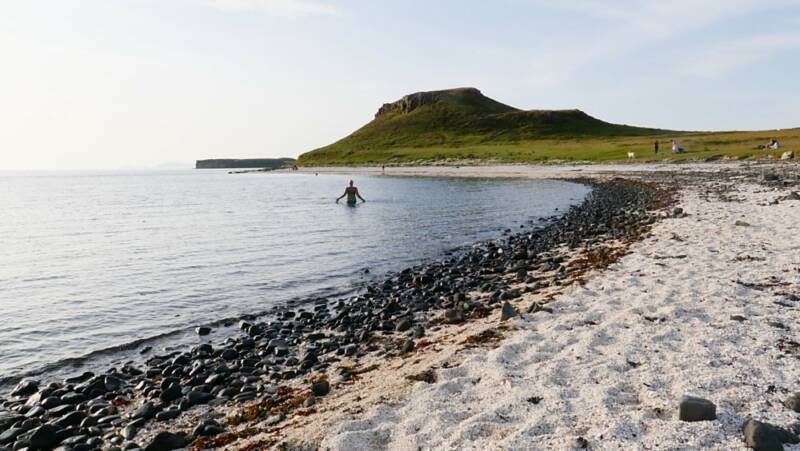
Look carefully at Claigan coral beach’s dazzling white sand, and you’ll find it isn’t sand (or coral) at all. Instead, the beach consists of sun-bleached skeletons of a red coralline seaweed known as maërl. Rarely for a seaweed, maërl grows a hard outer skeleton by depositing calcium carbonate in its cell walls. There are also immeasurable quantities of broken-up shells.
High tide is the ideal time to swim as the entry is mainly sandy, and there is a lovely, sheltered strip of water between the beach and the island of Lampay to potter around in. There are still a few stones underfoot as you get in, so I recommend wearing something protective on your feet.
At mid-tide, swimming in reasonably shallow water is possible, but more of the stones are exposed, and the entry is a bit trickier. At high tide, it is just under 200 metres across to the nearest point of the island. At low tide, you can walk across the bay to the island.
Getting there
The 1.8km path to the beach is well-signed from the car park. The path is generally good, with some gentle ups and downs. Comfortable, sturdy footwear is essential.
For a longer walk, you can always walk up the little flat-topped hill behind the beaches, known as Cnoc Mòr a Ghrobain, find the route on the full coral beaches walk description.
Easdale Island quarry pools, Argyll
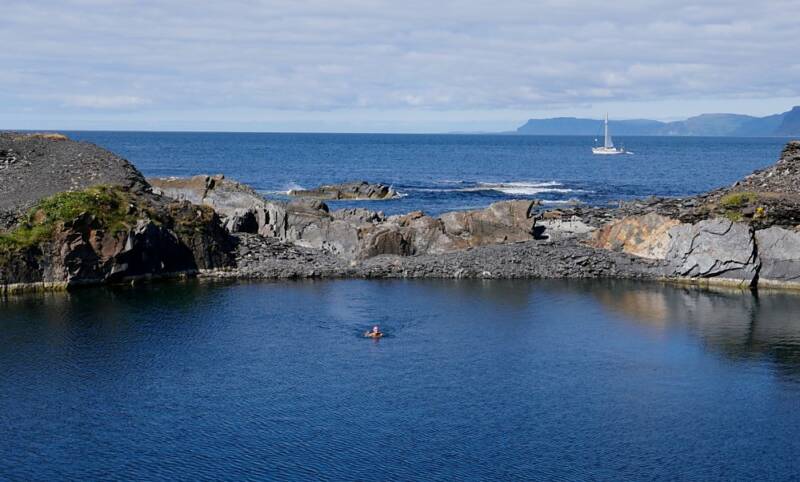
Easdale is the smallest permanently inhabited island of the Inner Hebrides. For almost three centuries, it was at the centre of the Scottish slate industry; at its peak, the island had seven quarries and a community of more than 500 miners.
There are five flooded quarry ‘pools’ and a couple that are still open to the sea. All have stunningly clear blue water and are very deep. They are gloriously sheltered places to swim and lovely and calm even when the sea around the island is rough.
Although it is possible to swim in all of the pools, only three have suitable entries. The two pools towards the northwest of the island are the easiest to access, and the pool near the southwest point has the best views. All these have sloping slate shingle beaches.
The smallest, L-shaped pool is the most popular for swimming. It is the shallowest and has the most gradually sloping entry. You can stick close to the edge and avoid the deeper sections. Both the other pools get deep very quickly, so be prepared if you don’t like deep water.
Getting there
From the Easdale jetty, skirt around the harbour and continue along the path that crosses the island’s northern end. Cross over the narrow section between two pools. At the far end, take a track down to the left, which will take you down to the entry of the high-sided quarry pool. A little further along the main track, you can follow a small path on the right, which will take you down to the entry of the smallest pool.
To get to the third pool, you can continue along the track to the south of the island. The entry for this pool is at the furthest corner, so you have to go around the edge (it is a bit rocky at some points) to reach it.
For a circular walk, taking in some spectacular views combine with the Easdale explorer route.
St Ninian’s Beach, Shetland
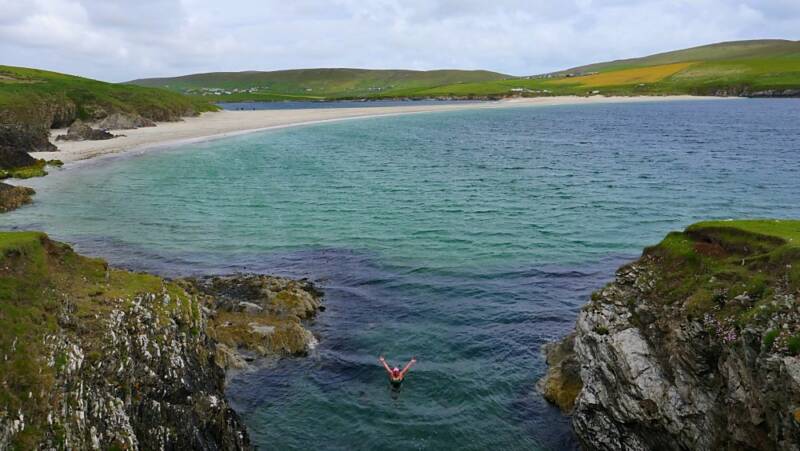
The beach at St Ninian’s Isle has always been high on my list of swimming locations to visit. Being a geography geek (it was my undergraduate degree subject), I’ve always been fascinated by coastal processes and formations.
You’ll find the largest tombolo (natural causeway) in the UK here; it was formed by waves from the Atlantic being refracted and diffracted around the island and meeting on the leeward side. In the central zone, sand and pebbles on the sea floor have been swept along by waves and accumulated to form the natural sand tombolo connecting the island to mainland Shetland. Only occasionally, during high spring tides and major storms, is the tombolo breached by waves.
Arriving here for the first time, mist hung low over the water and waves crashed on the northern shore. Despite this, the ribbon of sand connecting St Ninian’s Isle to the mainland still took my breath away, and the sea on the southern side of the beach was perfectly sheltered and ideal for swimming. On other days, depending on the wind direction, the northern side is better for swimming. On one occasion, I double dipped, playing in the waves on one side and then doing a longer swim in the perfectly calm water on the other side.
Getting there
From the A970 between Lerwick and Sumburgh, turn on to the B9122. Follow signs to Bigton and St Ninian’s Isle, which will take you on to a narrow road. Once in Bigton, keep following signs towards St Ninian’s Isle to reach the beach car park.
St Ninian’s beach is the crossing point to exploring St Ninian’s Isle, a lovely walk either before or after you have enjoyed your swim in the sea.
Safe and responsible swimming
- We must swim responsibly and recognise that swimming in cold water can be a potentially
dangerous activity. Having the right to roam (and swim) is a privilege we should never take
for granted. Always leave no trace, avoid disturbing wildlife and livestock, pick up litter and
try to leave your swimming spot better than you found it. - A major factor when considering swimming in these waters is the temperature. In sheltered
glens, the shallower lochs can reach 15°C in the middle of the summer, while lochans in
north-facing coires are frozen over for much of the winter and may only peak at 5°C in
summer. Immersing yourself in cold water carries significant risk, particularly if you are not
used to regular exposure to these temperatures. - Never swim alone. Always make sure you have someone keeping an eye on you.
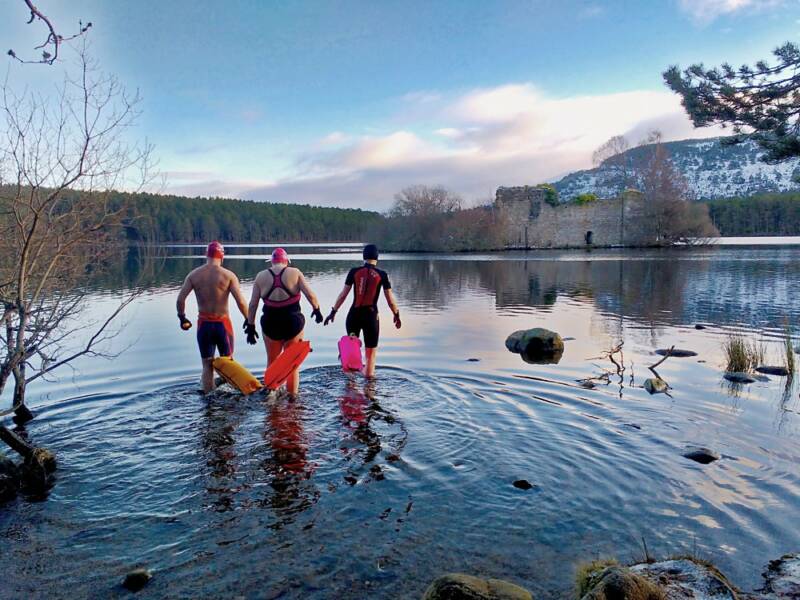
- Get into the water slowly, and focus on breathing out. Never jump in. Cold shock is the
body’s reaction to sudden cold. It may be tempting to plunge into the water quickly, but the
temperature is likely to take your breath away and cause you to gasp. If uncontrolled, this
can lead to hyperventilation. - Know your limits. Do not be tempted to stay in the water for too long. Never swim too far
away from the shore, as you risk getting too cold and struggling to swim back to the side
due to cold incapacitation. - Be prepared. Take appropriate clothing, including lots of warm layers, for after your swim.
Make sure all your kit is organised for when you get out. Food and a hot drink for
afterwards will help you warm up. - Be careful getting in and out of the water. Neoprene swim shoes/socks make it easier to get
out of the water when the entry is rocky. - Get dressed quickly after you the out of the water. Cover your head and core first. Your core
temperature continues to drop after you get out of the water. Once you are dressed, get
walking again as soon as possible to warm up.
Give it a go!
Inspired? Why take the plunge and go for a swim next time you are out for a walk? Just make sure
you have plenty of warm layers and a flask of hot chocolate ready for afterwards!
…………..
Swimming Wild in Scotland by Alice Goodridge features over 100 of the best wild swimming spots across the Scottish mainland and islands and is published on 11th May.
